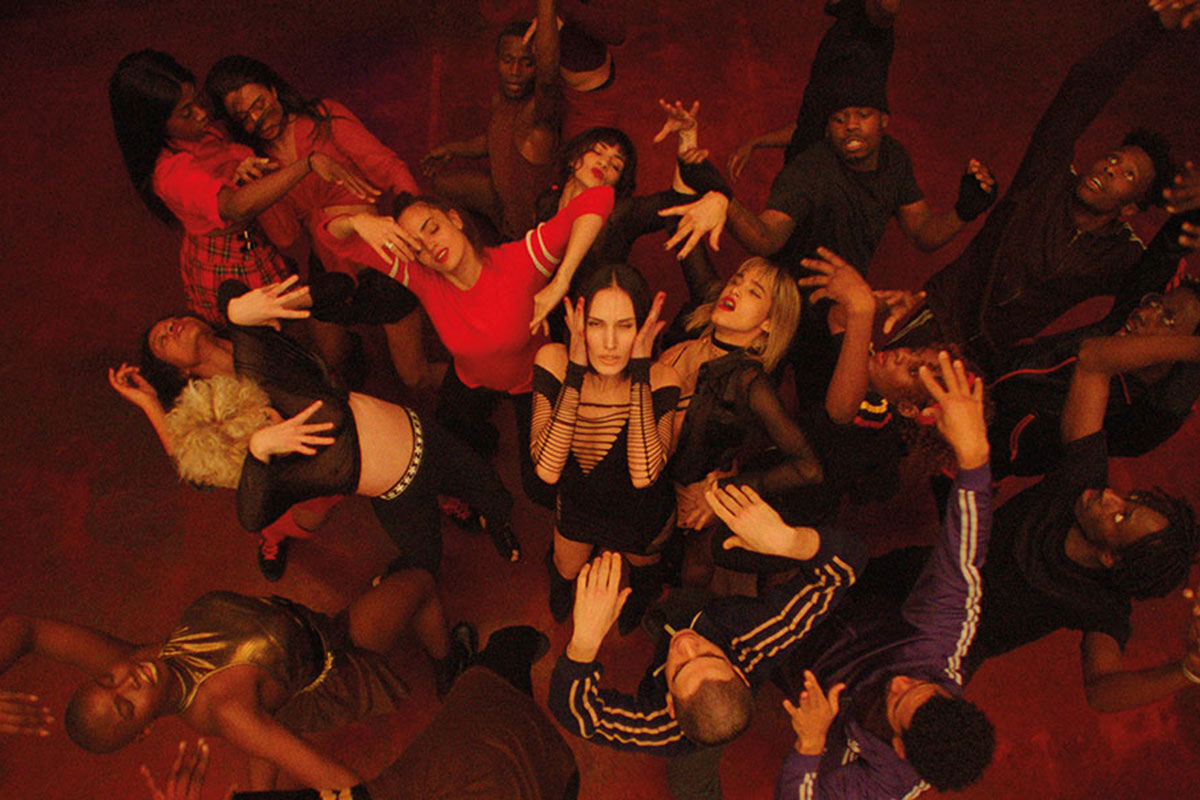When a film is centred around a group of dancers, it’s something of a given that the soundtrack will be a vital component in establishing the tone of the narrative at hand. This is certainly the case in Gaspar Noé’s Climax, which will come as little surprise to fans of his work, as he’s such a visual auteur, and the physicality of his protagonists is undoubtedly explored on this occasion.

Given the narrative of the film – that of a group of dancers at a party who find that the sangria has been spiked, and the drugs that kick in leads them down a dark, bleak trip that drags the viewer right along with them, again this highlights the essentiality of the score, for nothing quite gives off the feeling of a trip than music, as creative artists use instruments and melodies to strive to find a way to describe the ineffable feeling that comes with such an experience.
The opening track is Supernature by Cerrone, an upbeat tune that best encapsulates the tone of the film, as the French disco legend’s 1977 song is one that gives the talented dance ensemble so much to work with. They aren’t doing ballroom dancing, so let’s given them something to truly boogie on down to, with a catchy, twisty hook that loops over, and over and over. From this more obscure number we move into more familiar territory, with a funky disco classic in Patrick Hernandez’s Born to be Alive, featuring a beat that is impossible to not tap your toes to. The only downside is that in the original the vocals are so beguiling and yet this is an instrumental, meaning you anticipate their arrival the whole way through, and are sadly left wanting.
The tempo is maintained – as a soundtrack that almost follows the same journey as that of which the dancers are going on, fun and exciting to begin with, dark and anxiety ridden as we progress. With that in mind, we’re taken on to another classic hit, this time Pump Up the Volume by M/A/R/R/S; the only single the British collective ever released. With a dirty bass that makes you lift your head and pull a face, the vocals from Eric B. & Rakim are infectious, though there’s a sample in the background that sounds akin to an alarm of sorts, adding a tension, perhaps a warning sign for what’s to come?
We then move into a trancelike state with the next one, as Superior Race by electronic outfit Dopplereffekt begins, an unpredictable tune that truly kickstarts the trip. Synthesist Chris Carter’s Solidit is next, which carries an almost mechanical beat, which is fitting, for those on drugs like to get lost in the repetition of a song, swaying side to side, where any deviation from the melody threatens their balance, potentially ruining their high. Back we then go to the streets of Detroit via Dopplereffekt, this time with their track Technic 1200, though this is one of the album’s weaker moments. As Eminem once said, ‘nobody listens to techno’. Unless, well, you’ve had a few glasses of spiked sangria in which case it probably makes no difference what the DJ throws on.
What follows is one of the very rare contemporary songs on this album, though with a fondness to retro beats in the work of Kiddy Smile, you couldn’t tell. The song is called Dickmatized, and as you can tell from its title, it’s a rather novelty track, but as is the way with novelty records, this one is pretty damn catchy. Just be careful singing ‘you’ve been dickmatized’ to yourself in public – you may get funny looks.
From here we now enter into the original tracks composed for this movie, by French musician Thomas Bangalter – a regular collaborator of Noé’s, having worked together on Enter the Void and Irrerversible. You can tell with this track What to Do, that it’s a composer in sync with his director, for it’s an editor’s dream. Its stop-start approach allows for Noé to be so creative and move seamlessly between his characters, while maintaining a classic 90s dance feeling, which fits the timeline of the movie, which is set in that very period.
The next song is another by Bangalter, and it’s aptly entitled Sangria, the alcoholic cocktail which proves to be something of an antagonist where this production is concerned. This song takes the listener on a trip akin to that which the beverage takes the dancers on when they drink it. It’s calm and trancelike to begin with, but descends into something of a nightmare; pulsating and fast-paced. The sounds of an alarm in the background are deafening and incredibly uncomfortable.
We’ve reached that stage of the soundtrack. When things are starting to get weird, and feeling restless is becoming prevalent. The next track Voices by Neon continues this theme, taking you back to the movie in quite a striking way. This trance we’re in carries through to the next song The World’s by Suburban Knights, which feels like a song that has been crafted with the sole intention of being used in a musical montage, and here we are. Windowlicker by Aphex Twin comes next, which perfectly combines melody with a sense of chaos, emblematic of the film and the director’s thematic style. It’s absurd and weird, and then at times really beautiful. Very Radiohead-like in that regard.
Electron by Wild Planet has a real classic 90s vibe, as though you’ve just walked into an Ibiza nightclub. Before we take it back a decade, with the soundtrack’s most recognisable song, amidst a sea of obscurity – in Soft Cell’s Tainted Love, gloriously merged together with their cover of The Supreme’s Where Did Our Love Go. First of all, it’s a stone cold banger, and second of all, the two songs work so well together, maintaining that same rhythm, with Marc Almond’s vocals so perfect, both tracks tied together in lyrical sentiment too, and in the frontman’s indelible vocals you get a real sense of the loss that binds the two songs together.
From one excellent track to another, we move into Utopia – Me Giorgio by Giorgio Moroder, a song that almost contradicts the film, as a striking contrast to the uncomfortable scenes playing out in front of us, with vocals that are almost angelic, which is not a word you’d use to describe this feature. The next track contains no vocals at all, as another original track composed for the film by Bangalter. Well, original to a point, for it’s a newly crafted instrumental of the classic Rolling Stone’s hit Angie. You forget what a melodic track this is when you remove Mick Jagger’s jagged vocals.
The penultimate song lives up to its namesake, as it’s Mad by CoH Plays Cosey. It’s a track that makes the listener feel as though they are going insane, the perfect choice for this soundtrack, and perfectly placed too, as the fear the dancers feel truly hits them in the latter stages. These emotions they initially experience are exciting, but also terrifying, and this song encapsulates this notion. ‘Am I going mad?’ is the question the characters are asking themselves, and when listening to this track, it’s hard not to ponder that too.
Finally, we end with Gary Numan – which is never a bad thing. His track Trois Gymnopedies (First Movement) is easy to get lost in, with an almost otherworldly feel to it, that not only takes us on, but concludes our journey. This is a very unique film that is immersive and entrancing, and requires a collection of songs that will be very much in line with this – and that’s exactly what happens here. Only thing is, this isn’t a film that’s always enjoyable to sit through, so naturally it’s not always a soundtrack that’s particularly pleasant to listen to either.








Leave a Comment